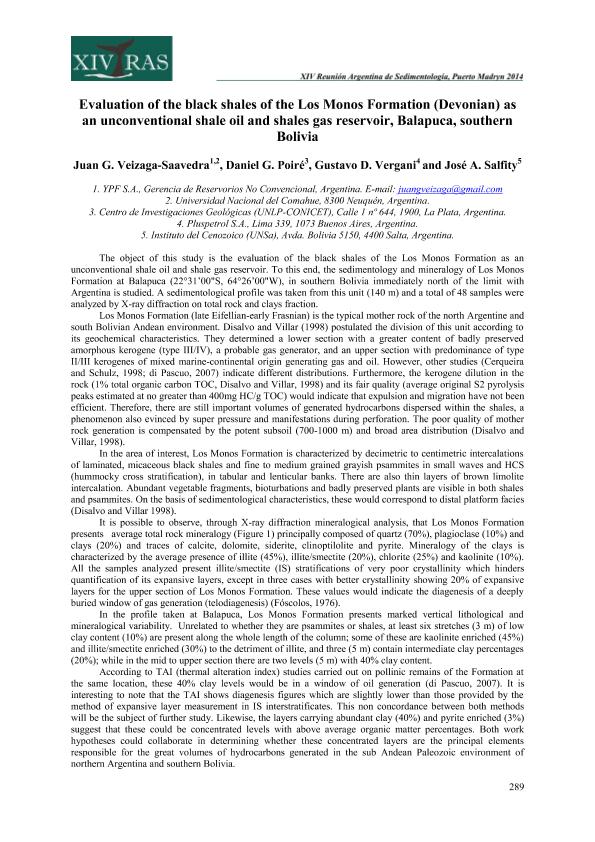Mostrar el registro sencillo del ítem
dc.contributor.author
Veizaga Saavedra, Juan Gonzalo

dc.contributor.author
Poire, Daniel Gustavo

dc.contributor.author
Vergani, Gustavo Dardo

dc.contributor.author
Salfity, Jose Antonio

dc.contributor.other
Allard, Jose Oscar

dc.contributor.other
Krause, Javier Marcelo

dc.contributor.other
Foix, Nicolas

dc.date.available
2024-04-15T09:32:32Z
dc.date.issued
2014
dc.identifier.citation
Evaluation of the black shales of the Los Monos Formation (Devonian) as an unconventional shale oil and shales gas reservoir, Balapuca, southern Bolivia; XIV Reunión Argentina de Sedimentología; Puerto Madryn; Argentina; 2014; 289-290
dc.identifier.isbn
978-987-96296-5-9
dc.identifier.uri
http://hdl.handle.net/11336/232915
dc.description.abstract
The object of this study is the evaluation of the black shales of the Los Monos Formation as an unconventional shale oil and shale gas reservoir. To this end, the sedimentology and mineralogy of Los Monos Formation at Balapuca (22°31?00"S, 64°26?00"W), in southern Bolivia immediately north of the limit with Argentina is studied. A sedimentological profile was taken from this unit (140 m) and a total of 48 samples were analyzed by X-ray diffraction on total rock and clays fraction. Los Monos Formation (late Eifellian-early Frasnian) is the typical mother rock of the north Argentine and south Bolivian Andean environment. Disalvo and Villar (1998) postulated the division of this unit according to its geochemical characteristics. They determined a lower section with a greater content of badly preserved amorphous kerogene (type III/IV), a probable gas generator, and an upper section with predominance of type II/III kerogenes of mixed marine-continental origin generating gas and oil. However, other studies (Cerqueira and Schulz, 1998; di Pascuo, 2007) indicate different distributions. Furthermore, the kerogene dilution in the rock (1% total organic carbon TOC, Disalvo and Villar, 1998) and its fair quality (average original S2 pyrolysis peaks estimated at no greater than 400mg HC/g TOC) would indicate that expulsion and migration have not been efficient. Therefore, there are still important volumes of generated hydrocarbons dispersed within the shales, a phenomenon also evinced by super pressure and manifestations during perforation. The poor quality of mother rock generation is compensated by the potent subsoil (700-1000 m) and broad area distribution (Disalvo and Villar, 1998). In the area of interest, Los Monos Formation is characterized by decimetric to centimetric intercalations of laminated, micaceous black shales and fine to medium grained grayish psammites in small waves and HCS (hummocky cross stratification), in tabular and lenticular banks. There are also thin layers of brown limolite intercalation. Abundant vegetable fragments, bioturbations and badly preserved plants are visible in both shales and psammites. On the basis of sedimentological characteristics, these would correspond to distal platform facies (Disalvo and Villar 1998).
dc.format
application/pdf
dc.language.iso
eng
dc.publisher
Asociación Argentina de Sedimentología
dc.rights
info:eu-repo/semantics/openAccess
dc.rights.uri
https://creativecommons.org/licenses/by-nc-sa/2.5/ar/
dc.subject
BLACK SHALE
dc.subject
LOS MONOS FORMATION
dc.subject
RESERVOIR
dc.subject
DEVONIAN
dc.subject
BOLIVIA
dc.subject.classification
Geología

dc.subject.classification
Ciencias de la Tierra y relacionadas con el Medio Ambiente

dc.subject.classification
CIENCIAS NATURALES Y EXACTAS

dc.title
Evaluation of the black shales of the Los Monos Formation (Devonian) as an unconventional shale oil and shales gas reservoir, Balapuca, southern Bolivia
dc.type
info:eu-repo/semantics/publishedVersion
dc.type
info:eu-repo/semantics/conferenceObject
dc.type
info:ar-repo/semantics/documento de conferencia
dc.date.updated
2024-03-08T15:28:21Z
dc.journal.pagination
289-290
dc.journal.pais
Argentina

dc.journal.ciudad
La Plata
dc.description.fil
Fil: Veizaga Saavedra, Juan Gonzalo. Consejo Nacional de Investigaciones Científicas y Técnicas; Argentina. YPF - Tecnología; Argentina. Universidad Nacional del Comahue; Argentina
dc.description.fil
Fil: Poire, Daniel Gustavo. Consejo Nacional de Investigaciones Científicas y Técnicas. Centro Científico Tecnológico Conicet - La Plata. Centro de Investigaciones Geológicas. Universidad Nacional de La Plata. Facultad de Ciencias Naturales y Museo. Centro de Investigaciones Geológicas; Argentina
dc.description.fil
Fil: Vergani, Gustavo Dardo. No especifíca;
dc.description.fil
Fil: Salfity, Jose Antonio. Universidad Nacional de Salta. Facultad de Ciencias Naturales. Cátedra de Geología Argentina y Sudamericana; Argentina. Consejo Nacional de Investigaciones Científicas y Técnicas; Argentina
dc.relation.alternativeid
info:eu-repo/semantics/altIdentifier/url/https://sedimentologia.org.ar/ras/XIVRAS_libro.pdf
dc.conicet.rol
Autor

dc.conicet.rol
Autor

dc.conicet.rol
Autor

dc.conicet.rol
Autor

dc.coverage
Nacional
dc.type.subtype
Reunión
dc.description.nombreEvento
XIV Reunión Argentina de Sedimentología
dc.date.evento
2014-09-01
dc.description.ciudadEvento
Puerto Madryn
dc.description.paisEvento
Argentina

dc.type.publicacion
Book
dc.description.institucionOrganizadora
Asociación Argentina de Sedimentología
dc.source.libro
Resúmenes: XIV Reunión Argentina de Sedimentología
dc.date.eventoHasta
2014-09-05
dc.type
Reunión
Archivos asociados
